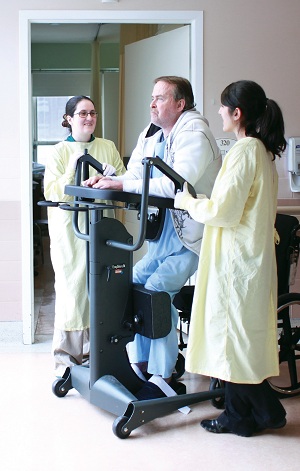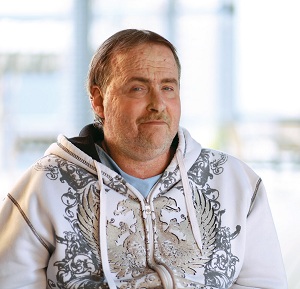 “The care I received at Toronto Grace was excellent,” says RT
“The care I received at Toronto Grace was excellent,” says RT
His wounds were the worst I had ever seen. When RT first came to us, he had a severe case of necrotizing fasciitis, commonly known as flesh-eating disease. There were severe open wounds covering his back, legs and arms, and he was in great pain. His medical condition was compounded by depression and drug addiction, and he'd already spent a year in acute care recovering from his ailments.
RT's prognosis was poor. Whatever the outcome, he would be very difficult to manage, financially, physically and emotionally. Most hospitals would be forgiven for wanting to walk away from him.
But The Salvation Army's Toronto Grace Health Centre (TGHC), a 119-bed rehabilitation and palliative care facility located in downtown Toronto, is not your typical hospital.
“We've always felt that in order to provide excellent care, each person's needs must be met individually,” states Marilyn Rook, TGHC's president and CEO. “We focus on the whole person—and RT was no exception.”
Accordingly, RT's journey back to health began in January 2011.
Complete Care
Upon admission to the complex continuing care unit, RT was immediately assessed by an interdisciplinary health team, which included doctors, nurses, a dietitian, a physiotherapist and a social worker. Together, they developed a plan to manage his pain, depression and nutrition, as well as deal with his addiction issues.
“When RT came to us, he was depressed because he had no family close by,” recalls nurse Millie Coote. “I was concerned about the amount of pain he was experiencing. He would cry each time we dressed his wounds, which were so severe that the new dressings were immediately soaked in blood. He needed the strongest narcotics to make the daily dressing changes bearable. However, after wound and pain consultants assessed him, we were better able to control his pain.”
As the hospital's registered dietician, I realized that aggressive and early nutrition intervention was essential to his recovery. Already thin and frail, he found it hard to keep food down. By providing him high-calorie/high-protein tube feeding overnight, we were able to dramatically meet most of his nutritional needs in this way and, as his condition improved, we were able to wean him off tube feeding completely.
“The next step in RT's recovery was providing a special mattress to relieve pressure for wound healing to begin,” states Dori Isakow-Weiss, the occupational therapist who worked closely with physiotherapist Angela Moora. “As exercise programs helped with his mobility, he eventually learned to drive a power wheelchair.”
But RT's care wasn't restricted to the physical. TGHC's spiritual care services also helped meet the patient's emotional needs.
“I had several visits with RT,” explains Salvation Army chaplain Sherri Golisky. “He shared memories of his childhood, Sunday school and his participation at Christian summer camps.”
“Once RT was able to get out of the bed, his mood changed,” says Chery Davis, the physiotherapy assistant. “He felt better and by Christmas 2011, could sit up in bed and, with a laptop we provided, was even able to connect with the outside world via Facebook.”
Setback and Recovery
 RT's wounds have almost all healed, and he has moved on to a new chapter in his life
RT's wounds have almost all healed, and he has moved on to a new chapter in his life
As RT's medical condition improved, his addiction issues surfaced. He had a history of drug use and it was suspected that he was going off-site to do drugs. After coming back late one evening, alcohol and marijuana were found in his system.
“RT didn't feel he had an addiction problem,” comments Joan Cass, the hospital social worker, “and so was resistant to the idea of attending a community program to help him deal with that and bad decision-making. Though we suggested other options, RT wanted to go back to living in an apartment in his hometown of Trenton, Ont. While the team felt he would be better in a supportive housing environment, we respected his decision to choose independent living.”
By the summer of 2012, Joan had found a one-year transitional program in a shelter in Kingston, Ont., that taught applicants life skills and prepared them for independent living. RT was ecstatic at the prospect of returning close to home. On August 20, 2012, after spending more than 20 months at the TGHC, RT left for a new chapter in his life.
In December, RT sent the hospital staff a Christmas card, thanking them for their hard work and concern and informing them that he was now living independently in a one-bedroom apartment.
A New Beginning
RT's journey was a long and complicated one. No single discipline could have done it. It was a shining example of a true collaborative team effort by the staff at the TGHC. As one specialist summed it up, we didn't just treat RT's external wounds, we treated the “whole person.”









Leave a Comment